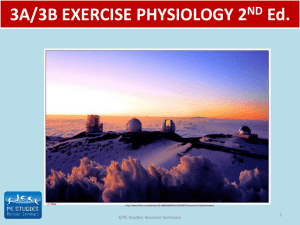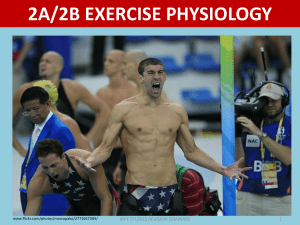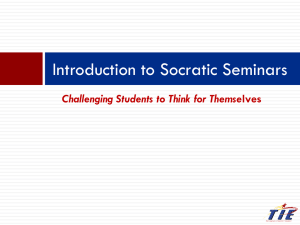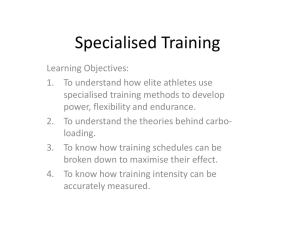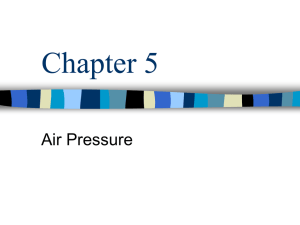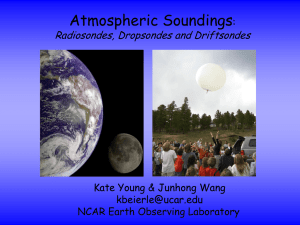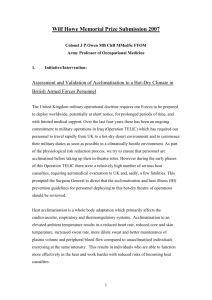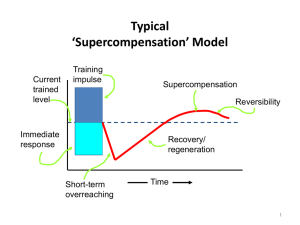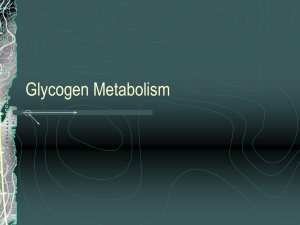3A/3B EXERCISE PHYSIOLOGY - PE Studies Revision Seminars
advertisement
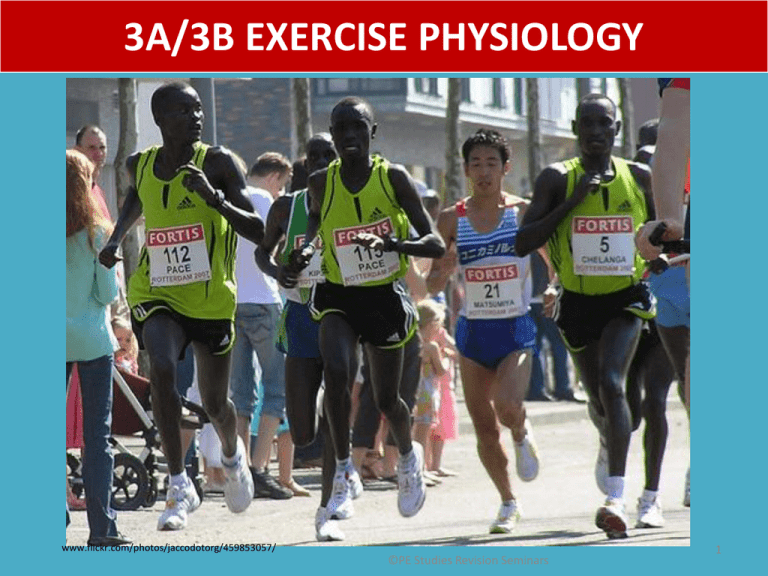
3A/3B EXERCISE PHYSIOLOGY www.flickr.com/photos/jaccodotorg/459853057/ ©PE Studies Revision Seminars 1 CONTENT •Environmental conditions and performance •Temperature regulation •Conduction •Convection •Radiation •Evaporation •Dehydration •Fluid replacement •Heat acclimatisation •Humidity •Altitude •Acclimatisation •Adaptation •Cold •Pollution •Jet lag •Nutrition and exercise •Protein •Fats/lipids •Carbohydrates 2 CONTENT •Fluids •Pre event meal •During the event meal •Recovery meal •Ergogenic aids •Illegal •High carbohydrate powders •Creatine •Sports drinks •Glycerol •Caffeine •Bicarbonate •Vitamins and minerals •Sports bars and gels •Liquid meal supplements •Iron •Building strength and bulk •Life stage variations in physical activity •Benefits of physical activity •National physical activity guidelines 3 CONTENT •Aerobic endurance •Anaerobic power •Muscular strength •Flexibility •Muscular power •Children and physical activity •Ageing and physical activity •Exercise adherence strategies •Principles of training •Periodisation •Tapering •Peaking •Recovery •Overtraining 4 TEMPERATURE REGULATION HEAT GAIN HORMONES ENVIRONMENT MUSCULAR ACTIVITY BASAL METABOLIC RATE Home HEAT LOSS Core temperature rises when heat gain exceeds heat loss which occurs when exercising, particularly in hot, humid conditions. The opposite occurs when heat loss exceeds heat production, as experienced in cold conditions. ©PE Studies Revision Seminars RADIATION CONDUCTION CONVECTION EVAPORATION 5 EXERCISING IN THE HEAT – EFFECTS OF DEHYDRATION HEAT EXHAUSTION: dehydration + ineffective circulatory system Dehydration as a result of exercising in the heat ↓ Plasma Volume ↓ Blood Pressure Dizziness Headache General fatigue Nausea Must stop, drink fluid and lie down with feet up! ↓ Stroke Volume ↑ Heart Rate Home ©PE Studies Revision Seminars Children have increased risk heat exhaustion due to following reasons: • Lower sweating rate than adults • Higher core temp during exercise •Less developed sweat glands • Smaller hearts leading to lower cardiac output 6 EXERCISING IN THE HEAT – HEAT ACCLIMATISATION • HOW TO ACCLIMATISE; 7-14 days living and training in heat is recommended The first sessions of heat acclimatisation should last for 15-20 minutes and be combined with light to moderate activity. It should increase to 45-60min daily for approx 8-9 days with an increase in exercise intensity & duration. Athletes who are unable to use natural acclimatisation should use; Artificial heat sources Climate chambers Saunas Sweat clothing Should be completed 4-6weeks prior to competition and then 2* per week leading up to competition to maintain benefits Never restrict fluids and avoid extending acclimatisation training beyond 14 days as it may lead to tiredness and overtraining! Home ©PE Studies Revision Seminars 7 ALTITUDE • Mexico City only Olympics held at altitude – 7500 feet World records smashed in throwing, sprint and jump events as a result of reduced air density, resulting in less friction. Also reduced gravitational pull on objects meant objects travelled further for a given force. Endurance performance was significantly hampered as a result of lower O2 partial pressures reducing O2 uptake and hence O2 delivery to the working muscles (see next slide). Low humidity also increased the risk of dehydration. Never to be held at altitude again! Athletics comps now held below 1500m (5000 feet). Every 300m above 1500m, aerobic capacity is reduced by approx 3%. During the Mexico Olympics, events such as the 10 000m recorded times 1min slower with the Kenyans, who trained at altitude, dominating endurance events! ©PE Studies Revision Seminars Home 8 760 mmHg – sea level 585 mmHg – Mexico City (2240m) 524 mmHg – La Paz, Bolivia (3627m) 410 mmHg – Wenquan, China (5100m) 231 mmHg – Mt Everest(8848m) Home ©PE Studies Revision Seminars 9 ALTITUDE – UNDERSTANDING HOW IT AFFECTS PERFORMANCE • When we inhale, oxygen moves through the lungs and into the alveoli where it diffuses to the blood to be transported to the tissues. Gas exchange takes place due to a pressure difference called a pressure gradient. The alveoli is high in oxygen and hence is high in pressure. The blood is low in oxygen and hence low in pressure. This pressure differential causes oxygen to move from the lungs into the blood • At altitude, there is a reduction in the pressure of oxygen entering the lungs. This reduces the pressure difference with the result being less oxygen diffusing from the alveoli into the blood. At sea level, oxygen has a partial pressure of 159mmHg At Mt Everest, oxygen has a partial pressure of 48mmHg In surrounding venous blood, oxygen has a partial pressure of 47mmHg A reduced pressure difference at altitude causes less Oxygen to be transported to the tissues, reducing exercise performance! Home ©PE Studies Revision Seminars 10 POLLUTION – UNDERSTANDING HOW IT EFFECTS PERFORMANCE • In preparation for the Beijing Olympics, many fears were raised regarding the effects pollution would have on the athletes, particularly endurance athletes such as marathon runners and triathletes. As a result Australian athletes travelled to China as late as possible, completing their final preparations in Australia! Haile Gebrselassie (pictured right), the world-record holder in the marathon and perhaps the biggest name in distance running did not compete in the Beijing marathon due to concerns about pollution, heat and humidity. Gebrselassie, 34, has exercise-induced asthma and feared that the conditions expected in China could damage his body and prevent him from competing at a high level in the future. ©PE Studies Revision Seminars Home 11 www.flickr.com/photos/thepaperboy/1487308213/ FUELING ENERGY SYSTEMS • The fuel source used for ATP production is based on the duration and intensity of exercise. • Low intensity – stored fats are the main energy source • As intensity of exercise increase, muscle glycogen contributes more - up to 90 minutes depending on intensity. Athletes “hit the wall” when muscle glycogen runs out. When muscle glycogen runs out, the stored liver glycogen kicks in to allow exercise to continue but performance starts to diminish. • Depletion of liver glycogen is referred to as “bonking” and affects the brain – decision making ability affected. • Fats now become the primary fuel source and intensity of exercise is reduced as fats are more difficult to break down • Depletion of fats results in protein being used as an energy source This is only likely to occur in ultra endurance events Home ©PE Studies Revision Seminars 12 SOCIAL BENEFITS PHYSICAL BENEFITS Development communication, leadership ad interpersonal skills Improved quality of life Reduces likelihood of anti social behaviour , particularly in children Increased social contact in elderly and prolonged living Improved fitness Improved social and community networks Increase muscle strength and bone density Prevention of obesity and weight management Improved immune system Increased energy levels BENEFITS OF PHYSICAL ACTIVITY MENTAL BENEFITS Improved self esteem Improved concentration Improved sense of well being Improved memory and learning Reduced stress and anxiety HEALTH BENEFITS Reduced risk of heart disease Reduced risk of stroke Reduced risk high blood pressure Reduced risk developing and dying from cancers Prevention and treatment type 2 diabetes 13 CHILDREN AND PHYSICAL ACTIVITY • ANAEROBIC CAPACITY Significantly lower ability to work anaerobically than adolescents and adults • Lower levels muscle glycogen – tire much more quickly as result Anaerobic training is seen to significantly improve children’s anaerobic capacity as a result of the following adaptations; ANAEROBIC CAPACITY • ↑ resting levels of PCR, ATP, and glycogen • ↑ anaerobic enzymes Home Childhood AGE Adolescence 14 ©PE Studies Revision Seminars 1. PERIODISATION OF PHYSICAL SKILLS TRAINING Annual Training Plan Phase of Training Preparation Phase Macro Cycles General Preparation Specific Preparation Competition Phase Pre Competition Competition Eval Transition Phase Eval Transition Phase Meso cycles Micro cycles THE ANNUAL PLAN Training program spread across the whole year The purpose of the annual plan is to ensure optimal performance occurs at the right time! This is achieved through the application of a taper prior to competition and the monitoring of fatigue and recovery to prevent overtraining ©PE Studies Revision Seminars Home 15 THE TRAINING WAVE VOLUME Increase volume 3-4 weeks prior to finals to ensure optimal fitness and skill levels. Increase recovery techniques General pre season sees aerobic fitness and basic skill work as priority – high volume Specific pre season involves anaerobic fitness, strength & power, sport specific skills – match conditions Each week sees application of mini taper in preparation for fixture with hardest work completed at beginning of week – maintenance of fitness levels the key! Taper just prior to finals to ensure ↑ glycogen stores, speed, power and agility control . Reduce volume during finals to ensure mental and physical freshness WEEKS 16 Home PRE SEASON COMPETITION FINALS TRANSITION
